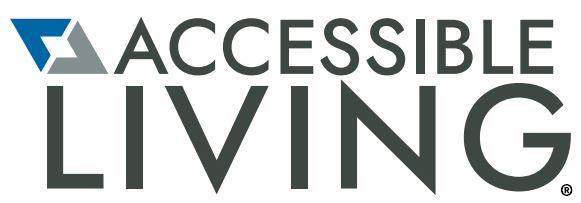Following Trends in Accessible Kitchens and Baths
By Jim Nowakowski
 There are a considerable number of people around the world who face accessibility challenges. Globally, estimates suggest over 2 billion people live with some form of disability, while the World Health Organization reports 20% of them experience significant difficulties in daily life. In the United States, 1 in 4 adults (27%) has a disability, according to the CDC. Of course, disability of any kind spelled another way is accessibility.
There are a considerable number of people around the world who face accessibility challenges. Globally, estimates suggest over 2 billion people live with some form of disability, while the World Health Organization reports 20% of them experience significant difficulties in daily life. In the United States, 1 in 4 adults (27%) has a disability, according to the CDC. Of course, disability of any kind spelled another way is accessibility.
Enter design
Whether it’s mobility issues, vision or hearing challenges, or mental health, accessibility can go beyond physical limitations and encompasses aspects like using the web, having access to information (i.e., braille). All of this creates exclusion, when in fact, designers want to move toward an inclusive world.
Universal Design is always at the heart of the latest accessibility trends in kitchens and baths. Designers and companies are aware of this need, and the following are some of the key accessibility trends in kitchens and baths:
Flexible layouts: Designing kitchens and baths with flexible layouts that accommodate various mobility aids, such as wheelchairs, walkers and scooters, is a growing trend. This involves optimizing space, ensuring clear circulation paths, and providing ample maneuvering room for users with mobility challenges. An useful reference can be found at 5 Layouts For Designing Your Dream Kitchen from the editorial staff at Luxe Interiors + Design.
Adjustable countertops and fixtures: Incorporating adjustable countertops, sinks and fixtures allows users to customize the height and configuration to meet their specific needs. This flexibility accommodates users of different heights, mobility levels and ergonomic preferences, promoting inclusivity and usability. Go to StarCraft Customer Builders for its excellent The Thirty-One Kitchen Design Rules, Illustrated piece.
Accessible storage solutions: Implementing accessible storage solutions, such as pull-out shelves, adjustable-height cabinets and drawers with full-extension slides, enhances usability and convenience for users with mobility limitations. Accessible storage ensures items are within reach and easily accessible without the need for bending or stretching. Go to PHX Home Remodeling for a comprehensive Storage Design Ideas For Your Kitchen Accessories piece.
Non-slip flooring and surfaces: Using non-slip flooring materials and slip-resistant surfaces in kitchens and baths improves safety and reduces the risk of falls, particularly for users with mobility impairments or balance issues. Textured tiles, matte finishes and slip-resistant coatings enhance traction and stability, enhancing accessibility for all users. Better Homes and Gardens has a deep dive into this topic in its Non-slip bathroom flooring ideas – 10 beautiful yet functional designs for underfoot.
Barrier-free showers and bathtubs: Barrier-free showers and bathtubs eliminate physical barriers and thresholds, allowing for seamless entry and exit without the need for stepping over obstacles. Roll-in showers, curbless shower stalls and walk-in tubs with low-entry thresholds provide easy access for users with mobility aids and limited mobility, promoting independence and safety. There are many manufacturers who provide a wide range of options, including Delta Faucet, Hansgrohe and others.
Accessible appliances and controls: Integrating accessible appliances and controls with user-friendly features, such as tactile markings, large buttons and intuitive interfaces, enhances usability for those with visual or dexterity impairments. Appliances with adjustable-height features and voice-activated controls further improve accessibility and convenience. Toulmin Kitchen and Bath has a go-to article on How to Design an Accessible Kitchen and Bathroom that will covers this topic.
Universal Design elements: Incorporating Universal Design elements, such as lever handles, touchless faucets and rocker switches, promotes accessibility and usability for users of all ages and abilities. These intuitive design features require minimal effort to operate and accommodate users with limited grip strength or fine motor control. Two references offer some insightful ideas: The Simplest Guide to Universal-Design Kitchen Remodels from L. Evans Design Group and Learn The Characteristics of A Universal Design Kitchen Remodel from Degnan Design Builders.
Task lighting and contrast: Implementing task lighting and contrast-enhancing features, such as under-cabinet lighting, task lighting over work surfaces and contrasting colors for fixtures and countertops, improves visibility and usability for users with visual impairments. Adequate lighting and color contrast facilitate navigation, identification and task performance, promoting inclusivity and safety. For a look into this world of lighting, go to Lightology’s Kitchen Lighting: Tips from a Designer.
By embracing these accessibility trends and principles of universal design, kitchens and baths can become more welcoming, functional and user-friendly environments for people of diverse abilities and needs. Integrating accessible features and design elements not only enhances usability and safety, but also fosters independence, dignity and inclusivity for all users.
Jim Nowakowski is president of Interline Creative Group.
Image by prostooleh on Freepik

